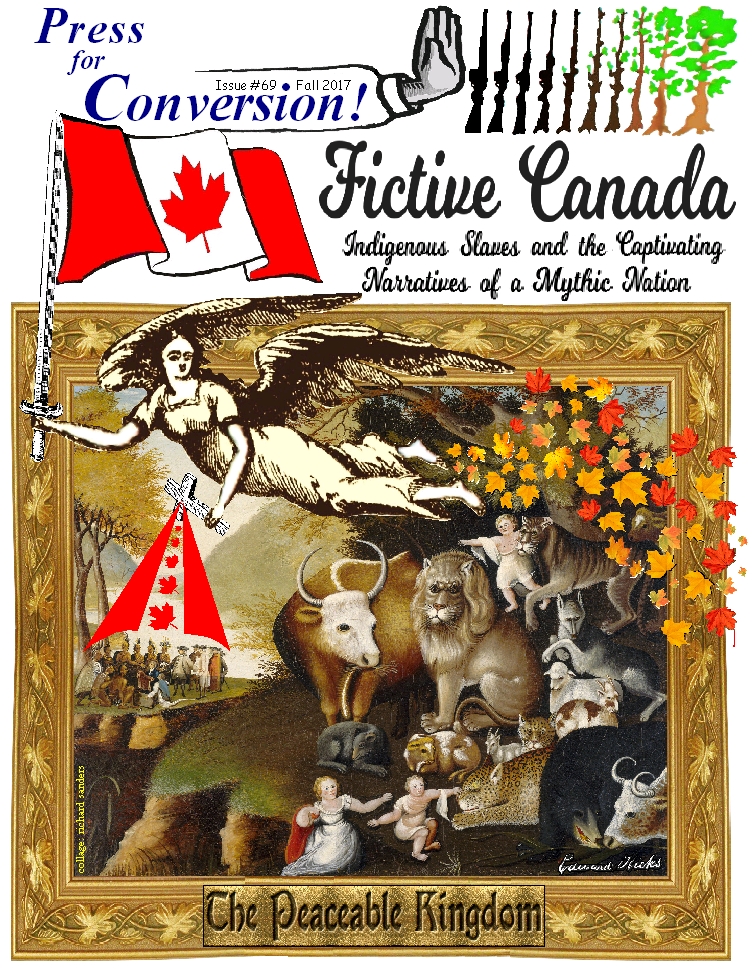
Fictive Canada:
Issue #69,
Press for Conversion! (Fall 2017)
Click here for info about
symbolism of the front cover collage |
|
|
Table of Contents 1-
True Crime Stories and the
2-
John Cabot & Britainís
> Why ďThe Dominion of CanadaĒ?
3-
Canadaís Extraordinary Redactions:
4-
Textbook Cases of Canadian Racism:
5-
From Popes and Pirates to Politicians and
Pioneers: >
The Canadian Legal Fiction of Original Crown
Occupancy
6-
Breaking the Bonds of Ignorance and Denial:
>
Oh say can you see? Blindsport
for Peaceable Racism
7-
Native
Captivity and Slave Labour 8-
Child Slavery in Canadaís
>
Jean LíHeureux:
|
John Cabot and Britainís Finding our National Origins
View this article from
Fictive Canada (pp.4-7) in PDF format Creation myths are as important to the formation of nationalist cults as they are to formulating the identity of religious groups. In fact, "[f]oundation myths are the primary organizing myths of nations," says Brock University history professor Joanne Wright, because "they establish a common history, a common origin, Ö a national identity Ö. and sanctify an imaginary beginning to the nation Ö."1 In Canadaís case, the age-old Peaceable Kingdom myth is built on the bedrock of creation stories that celebrate those brave explorers who led the way for European conquest. The history of these symbolic heroes, says University of Guelph history professor Alan Gordon, is used to "legitimize the possession of North America by Christian Europeans." Despite what Gordon calls "the specious logic inherent in such claims," the narrative of these "founding fathers Ö provides a binding social myth" and "strengthens the bond of brotherhood that nationals are supposed to feel for one another."2 The business of constructing Canadaís pantheon of mythic founders was aided in 1911 when the national archives published what it called "the chief manuscript sources of the earliest history of Canada."3 This, it said, brought together for the first time key documents about the European navigators who supposedly "discovered" Canada between 1497 and 1534. This Government of Canada publication exemplified the definitive process that Gordon described as reinvigorating and repackaging real historical people in order to fit them for the needs of the present in a continuous negotiation between history and politics. For instance, virtually every page of this 1911 book on "The Early History of the Dominion of Canada," was awash in references to the importance of seagoing ships in the creation and development of Canada as a nation. This official document resurfaced Cabot, and other founding European mariners, at a pivotal point in Canadaís naval history. It was in 1911 that Prime Minister Sir Wilfrid Laurierís ship of state finally ran aground and foundered in a federal election. After four majority governments, this dramatic upset for the Liberals was due, in large part, to the passage of a 1910 bill to create Canadaís first navy. This Liberal initiative was controversial in Quebec because Canadaís newly established navy was being set up to dutifully serve the British Empire. With a naval war brewing with Germany, and World War I on the horizon, opposition to Canadaís new navy was the key 1911 election issue in Quebec. It was the wind in the sails that allowed Sir Robert Bordenís Conservatives to sail to a federal victory.5 |
|
A case in point was the Italian Giovanni Caboto, a.k.a. John Cabot. As noted in the Canadian Encyclopedia, Cabotís "voyages provided the basis for Englandís claim to North America." 6 A "Heritage Minute" even reported that Cabotís "voyages of discovery" to "unknown lands"(!) were "responsible for the creation of Canada as we know it."7Similarly, Canadahistory.com, which calls itself "the #1 web site in the world about Canadian history, heritage and culture,"8 does not even hint at the racist dreams of conquest that characterized Cabotís imperial voyages. Instead, this websiteís main article on Cabot ó written in 1990 by a U.S. undergraduate student ó describes Cabot as "the second European to discover North America," and speaks uncritically of his "general accomplishments" and his "heroic travels."9 But this candy-coated pop history pales in comparison to the all-you-can-eat buffet of government tripe dished out for the 500th anniversary of Cabotís landfall in North America. In 1997, the Government of Newfoundland and federal authorities spent $20 million to celebrate Cabotís first voyage.10 The province kicked in $2.9 million, including $1.2 million for "over 1,300 artists and artisans."11 In critiquing this generous exuberance, Ovide Mercredi, then chief of the Assembly of First Nations, said Canadian governments "always say they havenít got the money" to improve living conditions for native people, "[b]ut they can sure find the money to celebrate something as flimsy as John Cabot."12 Even Queen Elizabeth II made the effort to grace Canada with her regal presence for the "Cabot 500" celebrations. The Innu Nation of Nitassinan, whose unceded land is claimed by Labrador and Quebec, took the opportunity to send a message to "Her Royal Highness." It read, in part: colonization here has been lamentable and has severely demoralized our People. They turn now to drink and self-destruction. We have the highest rate of suicide in North America .... We feel powerless to prevent the massive mining projects Ö. We have never ... signed any treaty with either Great Britain or Canada. Nor have we ever given up our right to self-determination Ö. We have been treated as non-People, with no more rights than the caribou [on] which we depend and which are now themselves being threatened by NATO war exercises and other so-called Ďdevelopment.í Canadaís joyous celebrations culminated on June 24, 1997. On that day, Queen Elizabeth, Prince Philip, then-Prime Minister Jean Chrťtien, countless dignitaries and 30,000 gleeful celebrants crowded into the tiny Newfoundland village of Bonavista, where Cabot is said to have landed 500 years earlier. His journey, said the Queen, "represents the geographical and intellectual beginning of modern North America." And as a hagiographic "Tribute to Her ... Golden Jubilee" explained in 2002, when Cabot planted the banner of King Henry VII of England Ö [it] was the beginning of the Canadian Monarchy, as the authority exercised by the Queen began with that claim.14 During 1997 celebrations of the half millennium since Cabotís "discovery," Katie Rich, then president of the Innu Nation, said that: When Cabot Ďdiscoveredí Newfoundland all he had to do was plant a flag and say ĎThis is crown landí .... Newfoundland wants to celebrate that. We feel there is nothing to celebrate. "Along the way a whole nation, the Beothuks, were wiped out," declared Rich. "We donít want that to happen to us."16 At a native-led protest, largely drowned out by the huge "Cabot 500" festivities in Bonavista, an Indigenous elder held a poignant sign saying, "It should be Remembrance Day for Native People." The placard had the image of a Beothuk named Demasduit, who had been captured by Englishman John Peyton Jr. and eight other armed men in 1819. Demasduitís husband Chief Nonosabasut and his brother were murdered while trying to prevent her abduction. Her niece, Shanawdithit, the last known Beothuk, was taken captive in 1823. Her mother and sister were also kidnapped and soon died of tuberculosis. Shanawdithit was made Peytonís servant for five years.17 By that time the Beothuk had endured more than 300 years of kidnapping, slavery and murder by Europeans. How many Canadians who are led to celebrate Cabotís legacy have ever even heard of Demasduit, Shanawdithit and their many forebears who were disappeared or killed? In light of Canadaís recent history of missing and murdered indigenous women and girls, we should recognise that the European enslavement and genocide of First Nations that has been going on for centuries, including the disappearance of an entire nation of people, the Beothuks. Ironically, some Newfoundlanders have renegotiated the concept of aboriginality by identifying themselves with the disappeared nation of Beothuks. These Newfoundlanders see themselves and the Beothuks, as fellow victims of exploitation by ruthless, profit-seeking imperialists from away. This process of self-identification as natives of "The Rock," says University of Guelph professor Alan Filewod, has helped some settlers to resolve the deep and culturally stressful contradiction between the sense of indigeneity and the awareness that it is built upon a history of genocide and invasion. "Newfoundlandís culture of working-class resistance," Filewood says, "was founded on the only act of total genocide in the British empire": Native aboriginal culture was not just enslaved and erased in Newfoundland, but every single indigenous Beothuk had been killed, through disease, famine, and murder, by 1830. He also notes that "Beothuks provide a textual prehistory of oppression" allowing "settler culture" to "displace its complicity in genocide into a shared history, in which the Newfoundland fisherman assumes the role of imperial victim."21
In 1496, Englandís last Catholic king, Henry VII, signed a contract or "Letters Patent" at Westminster, which was the centre of Catholicism in Britain. In this legal contract to take dominion over the riches of the "New Founde Land," Henry declared that he did "give and grant Ö to our well-beloved John Cabot" the "licence" to "conquer, occupy and possess whatsoever such towns, castles, cities and islands by them thus discovered." While the King gave Cabot the "full and free authority, faculty and power" to "find, discover and investigate whatsoever islands, countries, regions or provinces of heathens and infidels," there was an important caveat. Cabotís license only applied to lands that "were unknown to all Christians." With this imperial licence to wage an unending, plunderous war against undiscovered nonChristians, Cabot and "his sons or their heirs and deputies" gained the exclusive right to rule as the Kingís "governors, lieutenants and deputies." In exchange, they were "bounden and under obligation" to pay Henry "either in goods or money, the fifth part [20%] of the whole capital gained." The "capital" was defined as "all the fruits, profits, emoluments [earnings], commodities, gains and revenues."22 This royal charter stipulated that King Henry would acquire "dominion, title and jurisdiction" over all lands "discovered" by Cabot. Henry VII thus provided Cabot with the legal paperwork later used to justify Englandís extensive land claims over North America. This license ó steeped in imperial greed and religious hubris ó marked the symbolic birth and legal conception of our legendary Peaceable Kingdom. It is the foundation upon which the Dominion of Canada, as a supposed legal entity, is based. (See "Why ĎThe Dominion of Canadaí?" p.7.) Contracts are linguistic instruments that capture, hold, constrain, tie, restrict and otherwise force people to behave within the confines of an agreement. They are legally binding. Cabotís contract created a specific set of boundaries within which he was obliged or indentured to act. Just as in modern corporate law, Cabotís Letters Patent placed him in a fiduciary relationship. In modern legal parlance, Cabot had Henry VIIís "utmost trust and confidence," and was legally bound to "manage and protect" the monarchís imperial interests. 23 As such, Cabot and King Henry were held captive by the language of their legal contract.In 1497, the Milanese Ambassador in England, Raimundus, wrote that after "having obtained royal grants securing to himself the profitable control of whatever he should discover," Cabot found that "the sea is covered with fish" so plentiful that the English "kingdom will have no more further need of Iceland." Raimundus also revealed that Cabot had "set his mind on something greater" than just fish. Cabot wanted to reach Asia to gain access to "all the spices of the world and Ö precious stones [jewels]."24 Cabotís most powerful religious backer was Fr. Giovanni Antonio de Carbonariis, an Augustinian friar from Milan who was responsible for collecting papal taxes in England. The Vatican then owned one third of the entire English countryside. Leading Cabot scholar Alwyn Ruddock argued that Carbonariis, who joined Cabotís expedition in 1498, was the contact who first introduced Cabot to King Henry.25 Henryís contract to conquer and plunder said Cabot had "licence to set up our Ö banners and ensigns in any Ö island or mainland whatsoever, newly found."26 John Dayís 1497/98 letter (likely to Columbus), said Cabot and crew "disembarked Ö with a crucifix and raised banners with the arms of the Holy Father and those of the King of England."27 A 1497 letter from a Venetian merchant, Pasqualigo, said Cabot planted "a large cross" and a "banner of England."28 Using this symbolic magic, Cabot established the supposedly legal possession of these "newly found" lands for the Catholic Church and the English monarchy. But such acts of symbolism are only as effective as the imperial institutions of war and conquest used to enforce them. Pasqualigo also noted that Henry "promised" Cabot "ten armed ships as he desires, and ... all the prisoners to be sent away as he has requested."29 (Emphasis added.) Raimundus confirmed that the king promised to give to Cabot "all the malefactors, and they will proceed to that country to form a colony, by means of which they hope to establish a greater depot for spices in London than there is in Alexandria [Egypt]."30
Others were enticed by their religious fervour. "[S]ome poor Italian monks who all have promises of bishoprics" had joined Cabot, said Raimundus. "[H]aving become a friend of the Admiralís, if I wish to go I should have an archbishopric."33 Licensed by King Henry VII and blessed by the Catholic Church, Cabot set out to "conquer, occupy and possess" the lands of "heathens and infidels." Using "armed ships," monks, and violent thugs freed from prisons, they formed a colony, plundered what they could, and set up some bishoprics. The fabrication of Canada was off to an auspicious start! The Quest for Slaves In Cabotís day, European "explorers" were out to get spices, jewels and gold. But slaves were also expected as plunder from such voyages of imperial conquest. Cabotís journey came only three years after a fellow Genoese, Christopher Columbus, returned from the "New World" with slaves that he displayed in Barcelona and Seville. And, as Columbus informed Spainís monarchs, he would "give them as much gold as they need .... and slaves as many as they shall order to be shipped."34 Cabotís son Sebastian while working for the Spainís king in 1529, apparently purchased "50 to 60 slaves ... in Brazil, for ... sale in Seville."35 But whether John Cabot took slaves from "the new founde land" to England is unknown, though this was claimed by Sebastian. Relying on Sebastianís word, a chronicler of the early 1500s, Robert Fabyan, said that "three savage men" were "brought home" and "presented to the King" in 1499.36 Until the late 19th century, Sebastian was praised by historians as the discoverer of North America. When his unfounded claims to have led the voyages of his father were exposed as fiction, says Ruddock, Sebastian was seen as "a cheat, a liar and a charlatan."37 In 1898, historian Henry Harrisse wrote that despite: the encomiums lavished by modern historians on Sebastian Cabot..., it is proved beyond cavil and sophistry that he was only an unmitigated charlatan, a mendacious and unfilial boaster.38 We do know that Cabotís voyages were funded, in part, by merchants from Bristol. A major slave port since at least the ninth century,39 Bristol was a thriving centre for Englandís highly profitable slave trade in Cabotís time, and remained so for another 240 years. Henry VII, Cabotís royal benefactor, was the kingdomís most avid slave monger. In 1497, the year of Cabotís first expedition, King Henry smashed the Cornish Rebellion, killing 2,000 and selling thousands of captured rebels into slavery.40 Cabot was also funded by the London branch of an Italian firm, the Bardi, "so that he could go and find the new land." These Florentine bankers also financed Cabotís competitors, including such well-armed mariners as Amerigo Vespucci, Vasco da Gama, Bartolomeu Dias and Christopher Columbus.41 These were Cabotís fellow Christian "explorers" who ó sailing the seas for Spanish and Portuguese monarchs ó were opening the world for conquistadors to plunder such lucrative global commodities as slaves. Cabot was no stranger to the business of slavery. Venetian documents show that in 1483, after purchasing a female slave in the sultanate of Egypt, Cabot sold her in Crete.42 These facts about Cabot, his criminal henchmen and the royal and papal mentors who set them loose, reveal that the roots of our "Canadian values" include the crudest forms of greed, racism and xenophobia. These are the core values and belief systems upon which the criminal enterprise to "conquer, occupy and possess" Canada was originally conceived and built. References 1. Joanne H. Wright, Origin Stories in Political Thought: Discourses on Gender, Power, and Citizenship, 2004, p.20. http://books.google.ca/books?id=iJ2KrRs5RnwC 2. Alan Gordon, The Hero and the Historians: Historiography and the Uses of Jacques Cartier, 2010, p.5. http://books.google.ca/books?id=fYFSAAAAQBAJ 3. Henry Biggar (trans & ed), The Precursors of Jacques Cartier, 1497-1534: Collection of Documents Relating to the Early History of the Dominion of Canada, 1911, p.v. 4. Gordon, op. cit., p.7. 5. Terence Crowley and Rae Murphy, The Essentials of Canadian History, 1998. http://books.google.ca/books?id=0pFYBSaxB_wC 6. John Parsons, "John Cabot," The Canadian Encyclopedia, 1988. John Parsons, Learning Resources for the "John Cabot" Heritage Minute. 7. Ibid. 8. Advertising on Canadahistory.com 9. Derek Croxton, The Cabot Dilemma: John Cabotís 1497 Voyage and the Limits of Historiography 10. Brian Bergman, "Matthew Landing Launches Party," Macleans, Mar.17, 1997. 11. Cabot Celebrations - 500th Anniversary http://www.budget.gov.nl.ca/budget96/backgrou/tcrcabot.htm 12. "John Cabotís arrival in 1497 re-enacted in Newfoundland," The Daily Gazette, June 25, 1997. 13. Tanien Ashini, Vice President, Innu Nation, Letter from Innu People to Queen Elizabeth II, June 26, 1997. 14. Arthur Bousfield and Garry Toffoli, Fifty Years the Queen: A Tribute to Her Majesty Queen Elizabeth II on Her Golden Jubilee, 2002, p.14. http://books.google.ca/books?id=w8l5reK7NjoC 15. Cited in Ian Burrell, "Canadian Indians prepare ambush for Cabot voyagers sails into row with Canadian Indians," The Independent, June 24, 1997. 16. Alex Rose, Who Killed the Grand Banks, 2008, p.105. http://books.google.ca/books?id=wEPjLgwKspwC 17. Ingeborg Marshall, History & Ethnography of the Beothuk, 1996, pp.164, 244. http://books.google.com/books?id=ckOav3Szu7oC 19. Alan Firewod, "Modernism and Genocide," in Modern Drama: Defining the Field, 2003, p.170. http://books.google.ca/books?id=dqTz89_fFjgC 20. Ibid., p.169. 21. Ibid., p.170. 22. First letters patent granted by Henry VII to John Cabot and his sons, March 5, 1497. In Biggar, op. cit., p.9. 23. Encyclopedia of American Law, 2008. 24. Raimundus, letter, December 18, 1497. In Biggar, op. cit., pp.19-20. 25. Evan Jones, "Bristol, Cabot and the New Found Land, 1496-1500." In Exploring Atlantic Transitions, 2013. http://books.google.ca/books?id=gagTAgAAQBAJ 26. First Letters patent granted by Henry VII to John Cabot and his sons. In Biggar, op. cit., p.9. 27. The John Day Letter, winter 1497/1498 28. Lorenzo Pasqualigo, letter, Sept.23, 1497. In Biggar, op. cit., p.14. 29. Ibid. 30. Raimundus, op. cit., p.21. 31. Translation of "malfattore" to English http://en.dicios.com/iten/malfattore 32. Italian-English translation of "furfante" http://en.bab.la/dictionary/italian-english/furfante 33. Raimundus, op. cit., p.21. 34. Cecil Jane (trans. and editor), The Voyages of Christopher Columbus, 1930. 35. Jack Forbes, Africans & Native Americans: The Language of Race and the Evolution of Red-Black Peoples, 1993. http://books.google.ca/books?id=6aLAeB5QiHAC 36. Cited by J.A. Williamson, The Cabot Voyages and Bristol Discovery Under Henry VII, 1962. 37. Alwyn A. Ruddock, "The Reputation of Sebastian Cabot," Historical Research, May 1974, p.95. 38. Henry Harrisse, "The Outcome of the Cabot Quater-Centenary," The American Historical Review, Oct. 1898, p.61. http://www.jstor.org/stable/pdf/1832324.pdf 39. David Pelteret, Slavery in Early Mediaeval England, 1995. http://books.google.ca/books?id=b2xSnWr6ywEC 40. Siarl Ferdinand, "A Brief History of the Cornish Language, its Revival and Current Status," e-Keltoi: Journal of Interdisciplinary Celtic Studies, Dec. 2013. 41. Guy Gugliotta, "Discovery of a £16 Advance Sheds Light on John Cabotís Adventures," NY Times, June 18, 2012. 42. Edoardo Giuffrida, "New documents on Giovanni Caboto," in R.Mamoli Zorzi (editor), Attraversare gli Oceani: Da Giovanni Caboto al Canada Multi-culturale, 1999, p.63. |
|
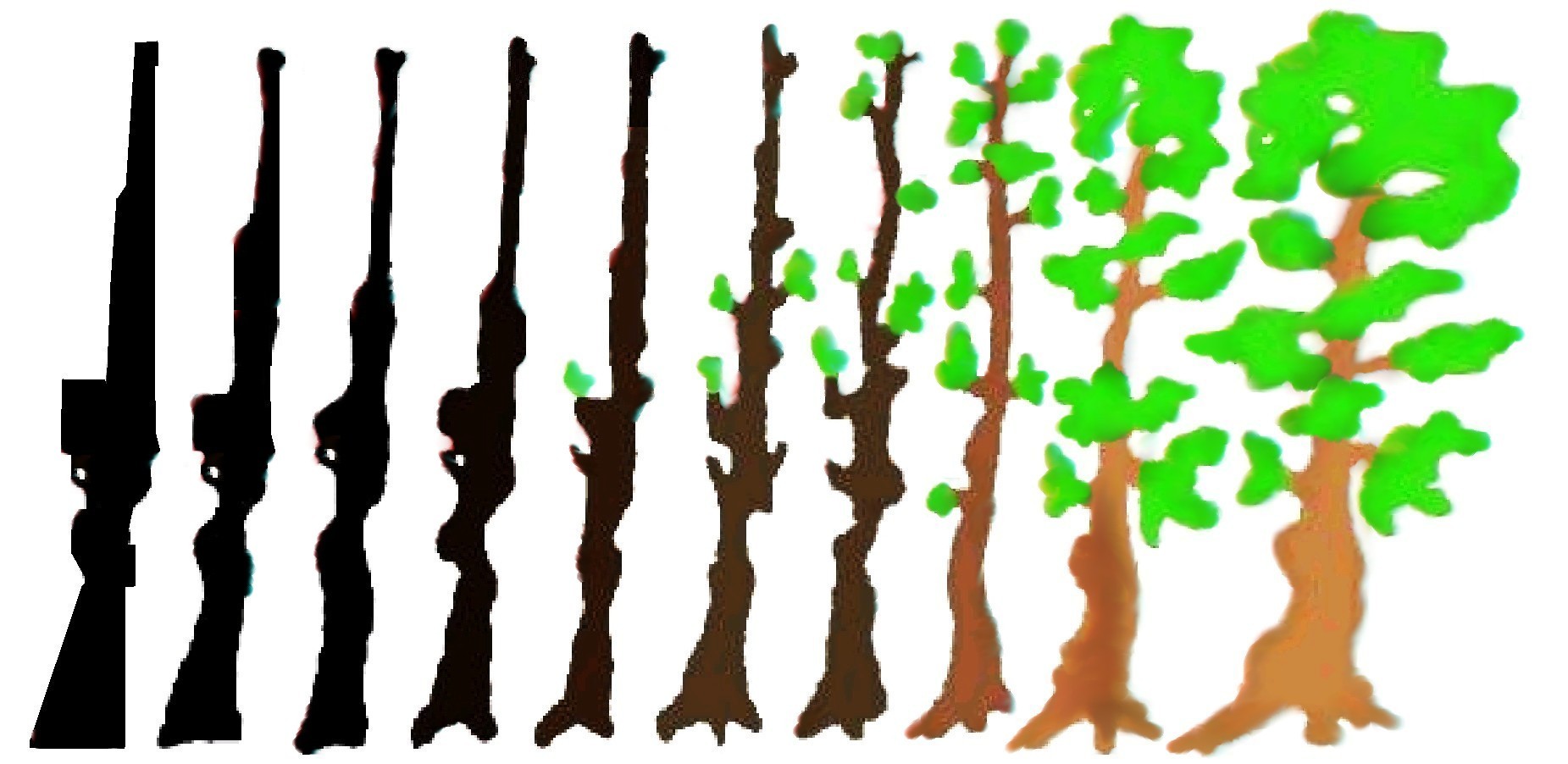 The
above
article was written for and first published in Issue #69 of
Press for Conversion (Fall 2017), magazine of the
Coalition to Oppose the Arms Trade
(COAT). The
above
article was written for and first published in Issue #69 of
Press for Conversion (Fall 2017), magazine of the
Coalition to Oppose the Arms Trade
(COAT).Please subscribe, order a copy &/or donate with this coupon, or use the paypal link on COAT's webpage. Subscription prices within Canada: three issues ($25), six issues ($45). If quoting this article, please cite the source and COAT's website. Thanks! |
|
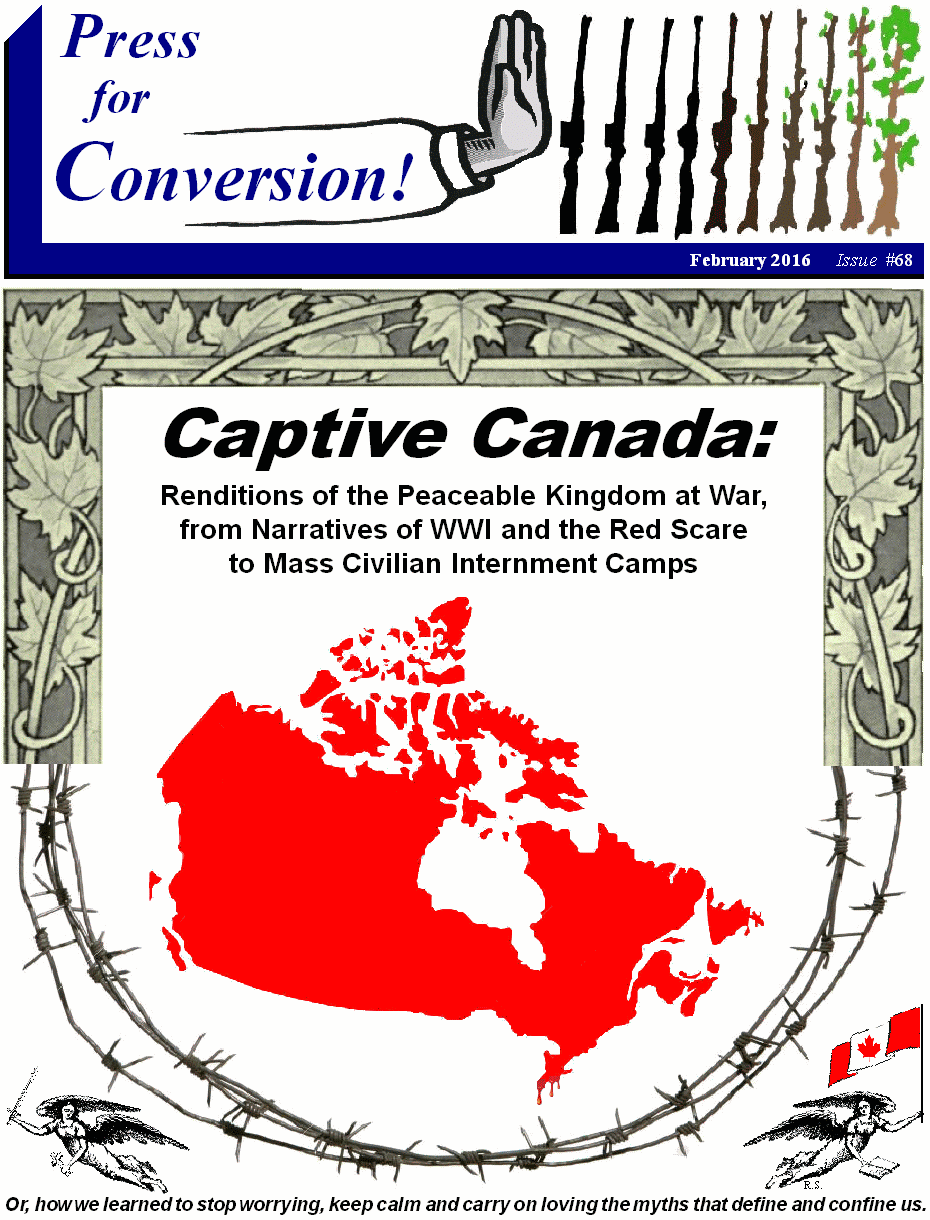 You
may also be interested in this back Issue of Press for Conversion! You
may also be interested in this back Issue of Press for Conversion!
Captive Canada: This issue (#68) deals with (a) the WWI-era mass internment of Ukrainian Canadians (1914-1920), (b) this community's split between leftists and ultra right nationalists and (c) the mainstream racism and xenophobia of so-called progressive "Social Gospellers" (such as the CCF's Rev.J.S. Woodsworth) who were so captivated by their religious and political beliefs that they helped administer the genocidal Indian residential school program and turned a blind eye to government repression and internment during the mass psychosis of the 20th-century's "Red Scare." (Click here to read this issue online.) Read the introductory article here: "The Canada Syndrome, a Captivating Mass Psychosis" |
|
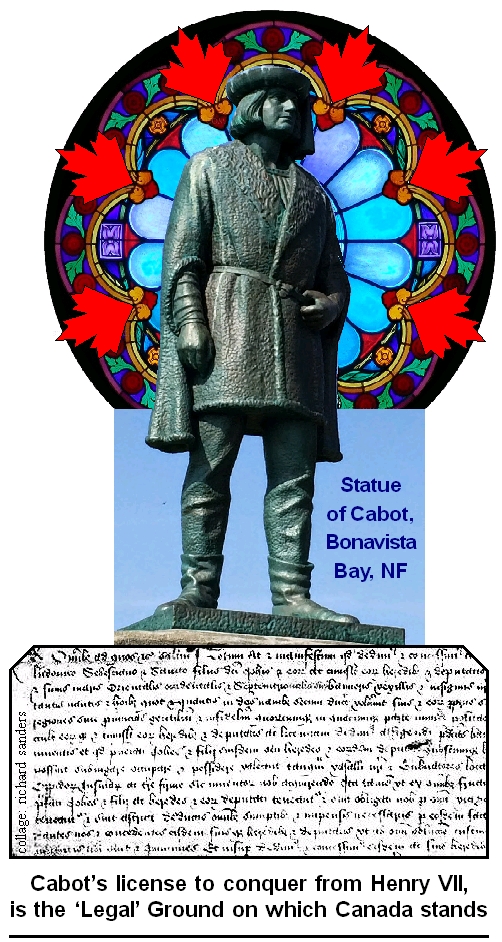 Canadian culture has long been filled with
inspiring tales of great seafaring captains. Such myths have often submerged the
fact that these globe-trotting fortune-seekers were driven by a voracious greed
to acquire power, prestige and fabulous wealth. Also largely ignored is the fact
that the selfish goals of Canadaís earliest European heroes were blessed by
church authorities, made legal by kingly contracts, conducted with cunning guile
and executed with the latest military technologies of death and destruction that
the world had yet seen. And, lest we continue to forget, these European icons of
Canadian heritage set the course for centuries of genocide against Indigenous
peoples.
Canadian culture has long been filled with
inspiring tales of great seafaring captains. Such myths have often submerged the
fact that these globe-trotting fortune-seekers were driven by a voracious greed
to acquire power, prestige and fabulous wealth. Also largely ignored is the fact
that the selfish goals of Canadaís earliest European heroes were blessed by
church authorities, made legal by kingly contracts, conducted with cunning guile
and executed with the latest military technologies of death and destruction that
the world had yet seen. And, lest we continue to forget, these European icons of
Canadian heritage set the course for centuries of genocide against Indigenous
peoples.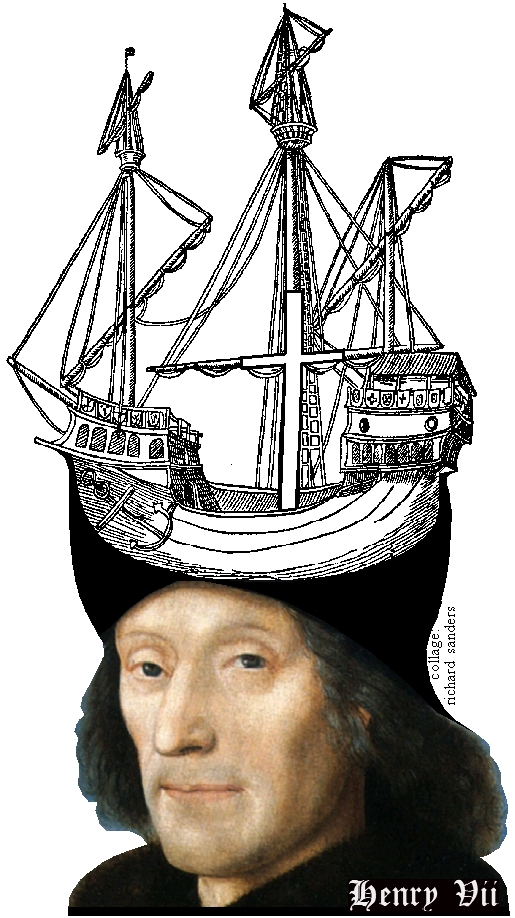 The Discovery and Conquest of Heathens
The Discovery and Conquest of Heathens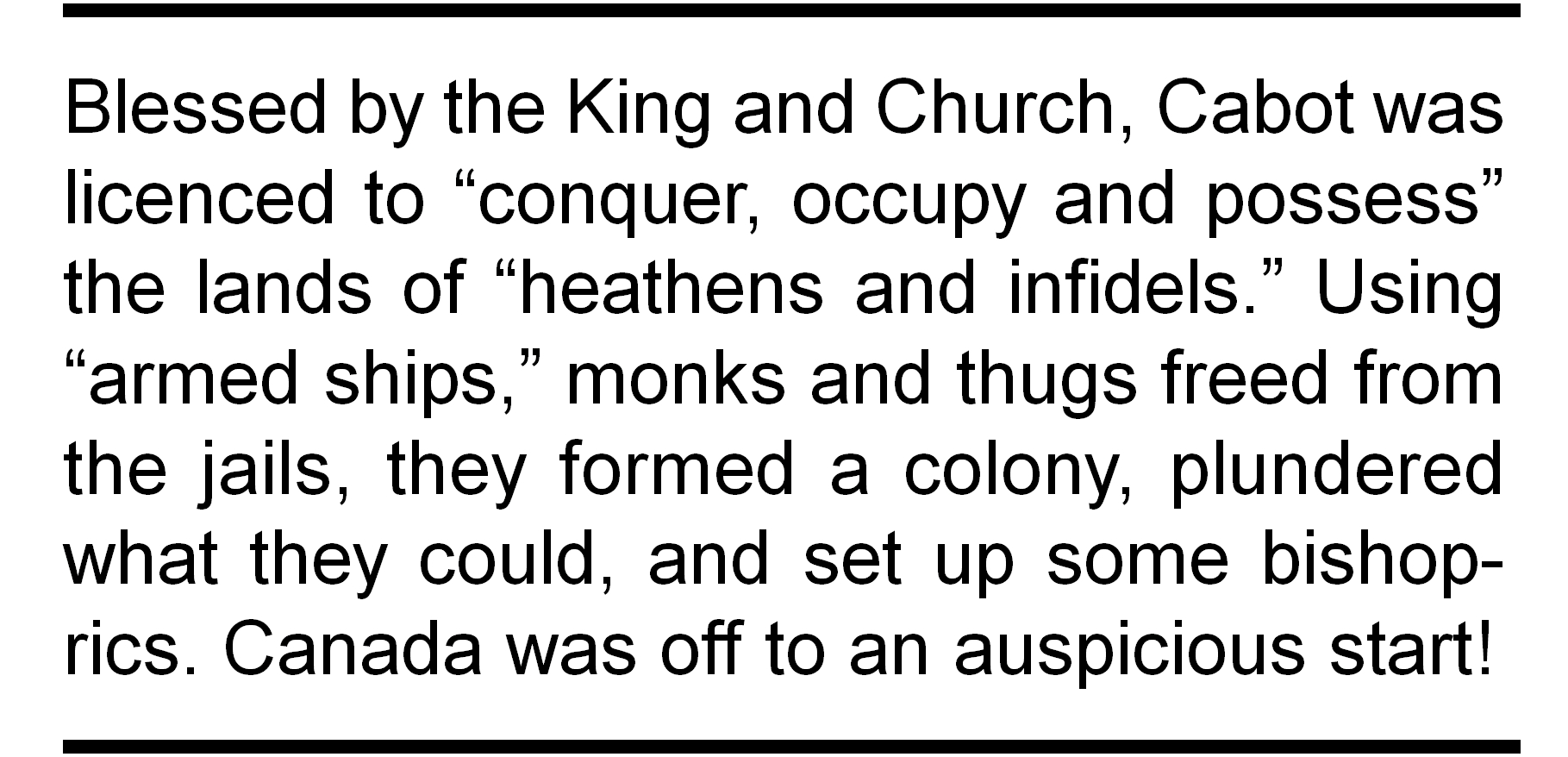 The reference to "armed ships"
with "all the prisoners" to go with them, is telling, as is the mention of
Cabotís intention to use "malefactors Ö to form a colony." In the original
Italian text, Raimundus called Cabotís promised recruits, malfatori,
which is literally the masculine form for evildoers, but refers to criminals,
delinquents, ruffians or mobsters.31 Calling
Cabot "the Great Admiral," Pasqualigo said he "can enlist ... a number of our
rogues as well." ("Rogue," from the Italian, furfanti, meant villain or
scoundrel.32)
The reference to "armed ships"
with "all the prisoners" to go with them, is telling, as is the mention of
Cabotís intention to use "malefactors Ö to form a colony." In the original
Italian text, Raimundus called Cabotís promised recruits, malfatori,
which is literally the masculine form for evildoers, but refers to criminals,
delinquents, ruffians or mobsters.31 Calling
Cabot "the Great Admiral," Pasqualigo said he "can enlist ... a number of our
rogues as well." ("Rogue," from the Italian, furfanti, meant villain or
scoundrel.32)